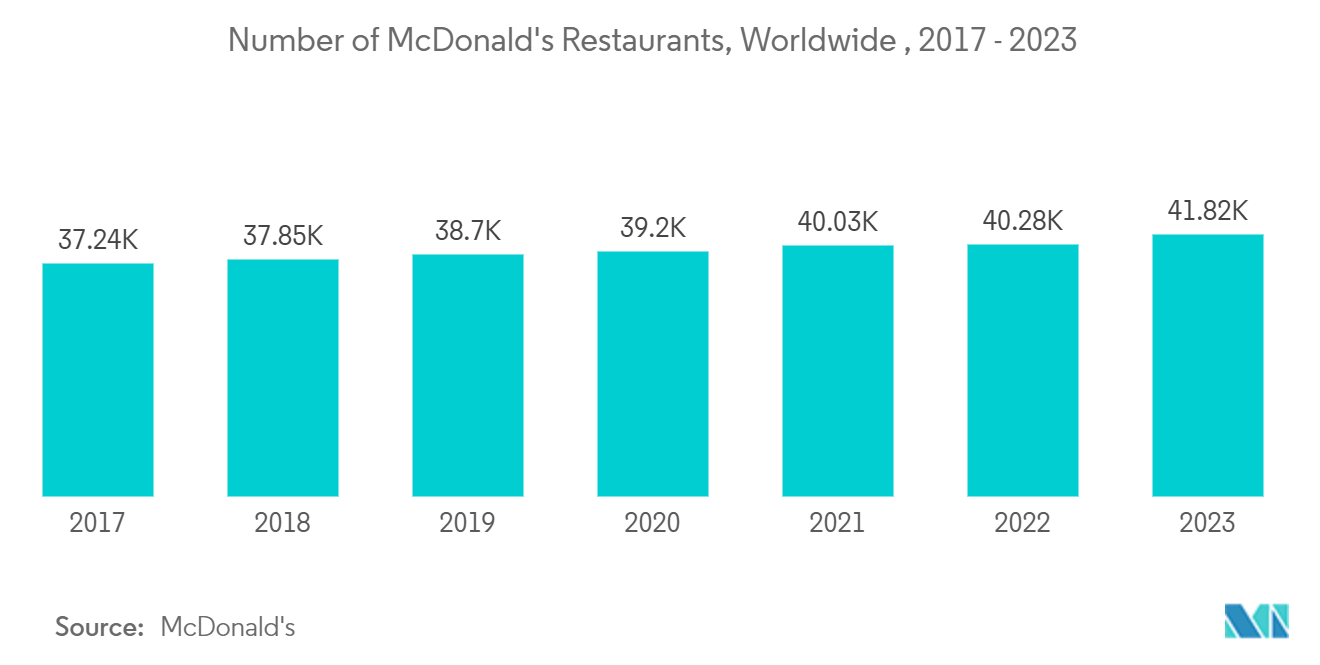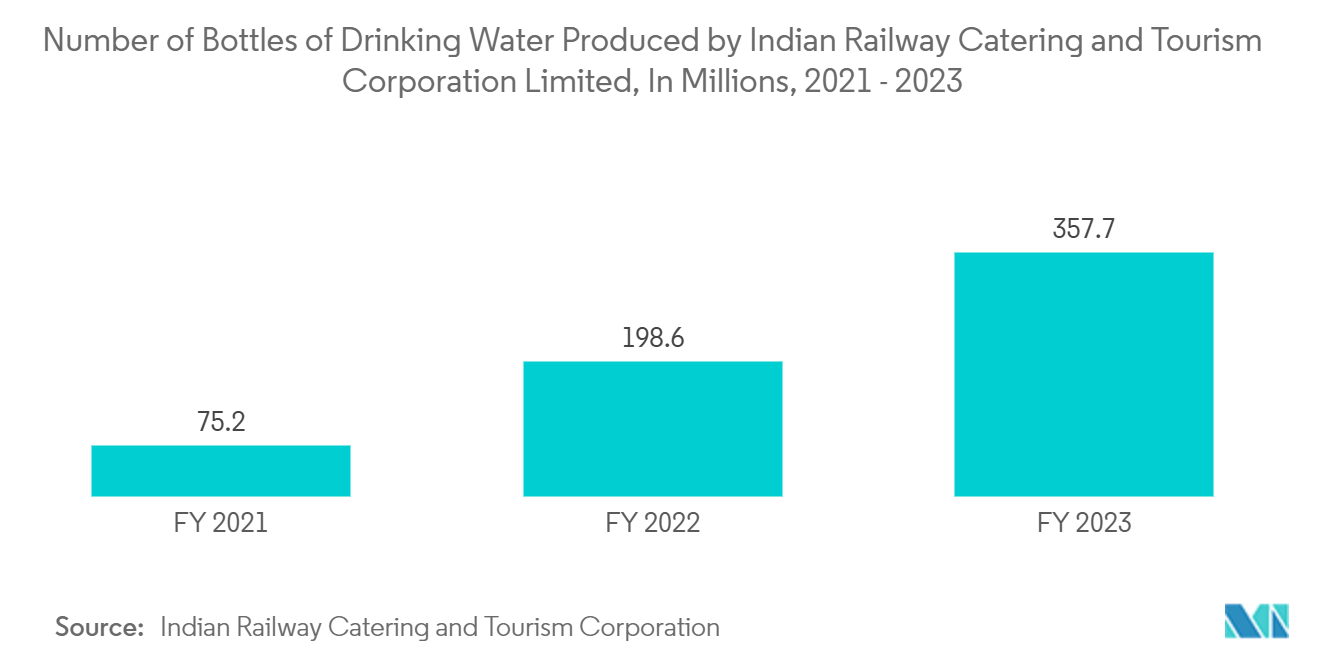Market Trends of Global Single Use Plastic Packaging Industry
Quick Service Restaurants Segment to Hold a Significant Share
- Quick-service restaurants (QSRs) provide affordable food options focusing on rapid service. These establishments are characterized by limited table service and a strong emphasis on self-service, setting them apart from traditional restaurants. QSRs typically offer a streamlined menu of easily prepared items, such as burgers, sandwiches, and fried foods, which can be quickly assembled and served. The efficiency of their operations allows them to serve a high volume of customers quickly, making them popular for those seeking quick meals.
- The majority of single-use plastic food service products utilized in QSRs are made from expanded polystyrene (EPS), polypropylene (PP), polyethylene terephthalate (PET), and polylactic acid (PLA). These materials are chosen for their durability, cost-effectiveness, and ability to maintain food temperature, contributing to the overall efficiency and customer experience in quick-service settings.
- Quick-service restaurant (QSR) menu items are typically consumed directly from their packaging. Consumers opt for fast food due to its convenience, rapid preparation, value, and affordability. Consequently, packaging is an essential food product component and must align with consumers' motivations and expectations for fast food. The packaging serves multiple purposes, including maintaining food temperature, preserving freshness, and facilitating easy consumption. It also plays a crucial role in brand identity and customer perception.
- As sustainability concerns grow, many QSRs are exploring eco-friendly packaging options to meet consumer demands for environmental responsibility while maintaining the convenience and functionality that fast food customers expect. The design and materials used in fast food packaging must balance practicality, cost-effectiveness, and environmental impact, all while enhancing the overall dining experience for consumers.
- In today's fast-paced environment, single-use plastic packaging has become integral to Quick Service Restaurants (QSRs). Consumers need more time for meal preparation at home, so they increasingly rely on fast food options. This shift in consumer behavior has led to a greater demand for convenient, on-the-go meal solutions. Single-use plastic packaging allows QSRs to meet this demand by packaging food efficiently, safely, and cost-effectively. These packaging solutions are designed to withstand various temperatures and maintain food quality during transportation. They also offer practical benefits such as leak resistance and easy handling, which are crucial for customers who often consume their meals while commuting or at their workplaces.
- The growing popularity of restaurants drives the expansion of the fast-food and quick-service restaurant (QSR) market. As major QSR brands increase their outlets, they create demand for single-use plastic packaging. This expansion is evident across various regions and cuisines, reflecting changing consumer preferences for convenient and affordable dining options.
- The trend is particularly noticeable in urban areas and emerging markets, where rapid urbanization and busier lifestyles contribute to the increased patronage of QSRs. For example, McDonald's, a global QSR brand, has been steadily growing its store count worldwide in response to the rising demand for quick meals. The company's global store count grew from 37,241 in 2017 to 41,822 in 2023, illustrating this trend. This growth was not limited to McDonald's alone; other major QSR chains expanded their footprints, further driving the demand for single-use packaging.

Asia-Pacific Expected to Hold Significant Share in the Market
- In Asia-Pacific, many densely populated countries and emerging economies, such as China and India, have a high demand for food services. Consequently, the need for single-use plastic packaging is increasing and will remain elevated during the forecast period. Plastic has been a crucial component of the packaging sector, which is central to consumer convenience culture. The versatility and durability of plastic make it an attractive option for various food packaging applications, from takeaway containers to beverage bottles.
- Due to plastic packaging's favorable cost-performance ratio compared to other materials, many food service and packaging applications have transitioned from traditional packaging materials like corrugated paper boards, glass, and metal to plastics. This shift is particularly noticeable in urban areas where the food delivery and quick-service restaurant sectors are rapidly expanding. The lightweight nature of plastic packaging also contributes to reduced transportation costs and lower carbon emissions in the supply chain, further driving its adoption in the food service industry across Asia.
- The region is expected to grow in terms of producing packaging products for domestic and off-premise food and beverage items, often ordered in bulk. This increase is driven by changing consumer habits and the growing demand for convenient, portable food options. Single-use plastic packaging is widely used in the region for various applications, including clamshells, bottles, trays, cups, and lids, particularly in fast-food establishments. The versatility and cost-effectiveness of these packaging solutions make them popular choices for businesses in the food service industry. However, this trend also raises concerns about environmental sustainability, prompting discussions about alternative packaging materials and recycling initiatives in the region.
- Due to its numerous end-user industries, the region is a significant investor and adopter of single-use plastic packaging. This adoption is evident across various sectors, including food and beverage, healthcare, and consumer goods. Several factors drive the regional market growth. Firstly, there is an increasing demand for packaged meals, particularly in urban areas where convenience is highly valued. Secondly, the expansion of restaurants and supermarkets has created a need for more packaging solutions to maintain food freshness and safety. Lastly, the rising consumption of bottled water and beverages, fueled by changing consumer preferences and lifestyle habits, has further boosted the demand for single-use plastic packaging in the region. These trends collectively contribute to the sustained growth and development of this area's single-use plastic packaging market.
- India stands out as a robust market in the region due to its large population and developing economy, leading to a significant increase in bottled water consumption. The Indian Railway Catering and Tourism Corporation Limited (IRCTC) has introduced its own bottled water brand, "Rail Neer," primarily sold on trains and at railway stations. With the rising demand for bottled water and the expanding railway sector, IRCTC has substantially increased production. In 2021, the corporation produced 75.30 million bottles, which grew to 357.70 million bottles in 2023.
- The packaging industry in India and China has experienced significant growth in recent years. This expansion is attributed to several factors, including establishing new manufacturing units, adopting eco-friendly materials, and increasing focus on research and development. These developments have led to the creation of innovative and visually appealing products, all manufactured locally at competitive costs. Additionally, government initiatives such as India's 'Make in India' program are expected to accelerate these further advancements in the packaging industry.
- The increasing production and consumption of bottled water in China have positively influenced the market. Chinese consumers are increasingly adopting more active and healthier lifestyles, which has led to a surge in demand for bottled water. This trend is further fueled by rising concerns about water contamination in the country's tap water supply. As a result, China has experienced a significant increase in demand for bottled water across various demographics.
- The growing health consciousness among consumers has prompted them to seek safer and more convenient hydration options, making bottled water an attractive choice. According to Eastmoney.com, this shift in consumer behavior is reflected in the projected retail sales figures for bottled water in China. The market is expected to show substantial growth, with retail sales projected to reach CNY 353.6 billion (USD 49.67 billion) in 2025, a notable increase from CNY 200.2 billion (USD 28.12 billion) in 2020. This growth trajectory underscores the expanding market potential and the changing preferences of Chinese consumers toward bottled water products.


